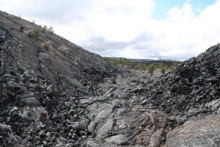Article
A Spanish term meaning “the bad country,” used by early Spanish settlers in the Southwest to describe regions that have a rough barren landscape covered in un-eroded lava flows, areas that are profoundly alkaline, and places that exhibit profound extremes in erosion patterns. New Mexico in particular has a number of exposed badlands with craggy black lava flows. The most notable malpais in the state is found in El Malpais National Monument, a federal monument situated in western New Mexico. This monument contains 133 square miles of lava flows and is home to a number of lava tube caves and volcanic cinder cones. Other lava well known lava flows in New Mexico are, the Carrizozo Malpais in south-central New Mexico and Jornada del Muerto Volcano lava field in central New Mexico.
Lava flows are formed when molten magma is expelled from a volcano’s magma chambers below the surface of the earth and is forcibly expelled from the volcano. Once magma reaches the earth’s surface, its name changes to lava. Lava is molten rock often composed of basalt, silica, potassium, and sodium. Malpais formations are created from a more viscous form of lava known by its Hawaiian name, a’a or aa. Once cool, this type of lava is identifiable by its sharp, craggy, and rocky surface.
"Badlands at El Malpais National Monument, NM, March 27, 2010" by Skinned Mink is licensed under CC BY-SA.
Manuscripts
References
Encyclopædia Britannica Online
N.d. Volcano. http://www.britannica.com/science/volcano, accessed October 13, 2015.
Mangum, Neil C.
1990 In the Land of Frozen Fires: A History of Occupation in El Malpais Country.
Southwest Cultural Resources Center Professional Papers 32.
New Mexico Museum of Natural History and Science
N.d. New Mexico: Land of Volcanoes. http://www.nmnaturalhistory.org/volcanoes-of
-nm.html, accessed October 13, 2015.

